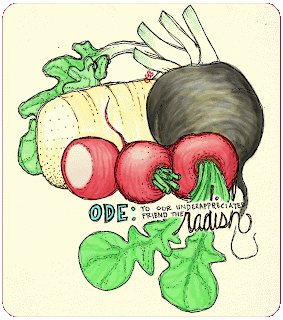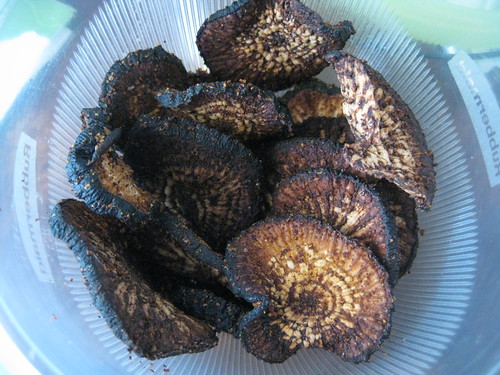Saturday, May 21, 2011
Ode 002: The Radish
In order to allow move on to important upcoming posts, I have a similarly important one to finish up on. This is my second Ode!
The radish: Crispy, refreshing, and bright when raw, cooling and juicy in salad, is a doppelganger of vegetables. It has the ability to suggest qualities of potatoes, water chestnuts, nuts, jicama, and potatoes-- but only suggest, and not emulate. The radish feels no need to hide his true identity, unlike many superheroes.
Red radishes, black and icicle radishes, Daikon and Mu-- they are so unexplored in Western culture, and I vote we change that, stat.
The classic little red radishes, (the "Oh-I've only-had-radishes-raw-in-salads" Radishes), begin our venture into the unnappreciated world of these coolly hot little roots. If you get a good radish-- really fresh radishes, from a good enough place-- they are NOT all that spicey. They still have a whisper of a bite that makes them interesting, but nothing eye watering. Try slicing them into coins and eating guacamole with them. Awesome. They can also be sprinkled around a roasting chicken or added to the roasting pan of veggies. The larger ones, quartered, and the smaller ones, halved or left whole, roast dry beautifully with seasalt and cayenne. They transform into something magical and silky when cooked in a wet environment and topped with butter and herbs.
The larger radishes, like black, watermelon, and icicle, have a very important place in my heart, and my kitchen. When you get out the mandolin (the one your mother gave you, with the melted edge), and slice these guys thinly, you are borderlining ceremony, for something spectacular is on the horizon. Toss these with olive and coconut oils, chili powder, sea salt, and black pepper. Now, bake them at 400 degrees on a pizza stone or something, 10-15 minutes on each side, until they crisp up. If you let them burn, they are bitter-- if you undercook them, they are soft-- but if you cook them JUST right and let them cool, they rival any kettlechip. They're done when they've gone black (but not carbon) all the way through.
Last but not least, we come to two gargantuan varieties: Daikon and Mu. Daikon is used grated in Japanese cuisine to add a cool aspect to salty grilled fishes for a refreshing palette cleanse. Without Mu (a monster, melon looking radish) we wouldn't have kimchee or kaktugi-- travesties, both! Daikon also works into chips as mentioned above, but tends to yield slightly softer results. Kiriboshi Daikon is a shredded, dried daikon, awesome to use in dishes to add texture and a mellow nutty sweetness. For radish kimchee, cube Mu (or daikon) and lots of green onions. Puree lots and lots of garlic and ginger with fish sauce, salt, and korean red pepper flakes. Put both vegetables and puree in a jar and shake like mad until evenly coated, then leave on the counter for about 5 days before chilling for another 5. Kaktugi! Like magic!
And with that, our second Ode. Tell me, have you yet to embrace these humble little beings? Tell me a radish's tale.
More to come, don't you worry.
Subscribe to:
Post Comments (Atom)



No comments:
Post a Comment